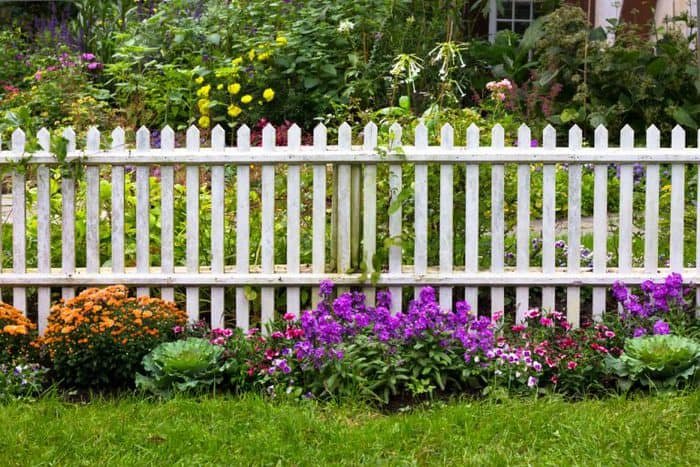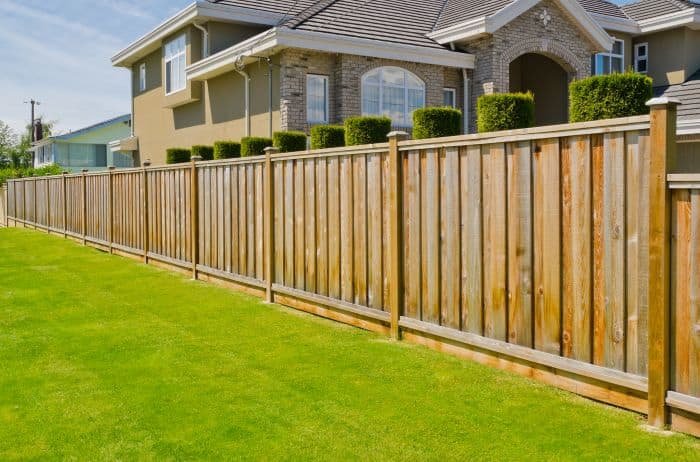How Much Concrete Per Fence Post
Are you wondering how much concrete per fence post you’ll need for your fence project? You really don’t want to find yourself out of concrete halfway through the building process, but you also don’t want to end up having to store several bulky bags of extra concrete that you didn’t need to buy in the first place.
Generally, for each fence post, you will need enough cement to fill a hole that is a third to half as deep as the post’s above-ground height and three times as wide (in diameter) as the actual post.
That leaves you with the job of measuring out the fence posts so that you know how large each post hole should be. Once that’s finished, there are a few things to consider, including which cement type to use, how many bags to buy, and how to install them. Read on to discover your specific fence project’s needs and how to get it done right the first time.
Table of Contents
How Much Cement Will You Need for Your Project?
So, you’re building your fence. You’ve got your fence posts, and you’ve measured out your property boundaries. Maybe you’ve got the distance between each post marked and your shovel at the ready. The question of how much concrete to buy for your fence installation may still be fuzzy.
When researching how much cement to purchase, the bag size may not be specified explicitly, but in most instances, the size being referenced is that of a 50lb cement bag.
As stated above, the hole for your post should measure three times the diameter and roughly a third of the fence posts’ height. The cement needed to fill that hole will depend on the volume of the hole, which you can now calculate based on those measurements. HGTV further offers a beneficial chart that helps you identify precisely how much you will need for your fence post installation.
You can also use this calculator to figure it out. Simply enter the measurements required, and it can help you estimate what you should buy to set yourself up for success.
Then you can get digging, filling, propping, and drying those posts around your property.
What Kind of Concrete Gives Me the Best Value?
With there being upwards of 19 different cement types, perhaps you’re wondering exactly what kind of cement to purchase and pour into the fence post holes. Each cement type has a purpose, though, and some are more relevant to this project than others.
While most professionals would agree that you can use any concrete mix that you want and it will get the job done, it is highly recommended that a fast-setting concrete be used for fence post holes.
Fast-setting concrete is the best option because of its ability to dry quickly and be set within a few hours of pouring. It makes the job go much faster, and the result come to fruition much sooner.
Do I Have to Use Cement on My Fence?
Maybe you’re wondering if cement is even necessary for your fence post holes. After all, it could save hours of work and a lot of hard-earned money just to skip that part altogether. The integrity of the fence, though, may not be as well off as your wallet if this was the decision that was made.
Cement offers the benefits of:
- Keeping the fence posts upright and gives stability
- Makes them much sturdier against any damage or pressure
- Increases the weight-bearing abilities significantly
- Less likely to need repairs
- Need for reinstallation later on is much less likely
In short, if the fence posts are grounded in a cement foundation, they will withstand much more wear and tear and maintain their strength and stability for much longer than if they had a gravel or dirt foundation.
How to Install Fence Posts in Concrete
Once you’ve purchased the necessary amount of concrete, the following steps will guide you through the process of proper installation. Learning these steps is vital to ensure you don’t waste any of those concrete bags!
Add the Gravel
After you’ve dug your hole as described above, the next step is gravel. Gravel is an essential part of any concrete laying process to keep water drainage happening beneath the cement and keep it dry. You’ll want to use crushed stone or pea gravel for the best results.
Once you have your gravel ready, you then need to fill the hole with at least 6 inches worth of stone to lay beneath the concrete, packing it in and smoothing the top with the fence post or another tool that can do the job.
Level and Brace the Fence Post
Once the gravel is packed in, take the fence post and brace it inside the hole, attaching rope or 2x4s to keep it upright. Use a level to make sure that the post is exactly upright to avoid any problems down the road.
You will keep these braces intact throughout the cement pouring process to maintain the fence post’s integrity while the concrete is setting.
Pour the Concrete
If you chose fast-setting concrete, then you will pour the dry mix directly into the hole, filling it to about a few inches from the top of the hole. Be sure it’s an even pour and level the top for a smooth appearance.
If you chose anything other than fast-setting concrete, you’d need to mix it first and then pour it in, keeping the pole level and stabilized until it dries.
Pour Water onto the Concrete
To get the fast-setting concrete to begin going from a powder to a solid block, you must add in the right amount of water. You want to add about a gallon of water per 50lb bag of concrete. Pour the water directly over the concrete and allow it to soak through thoroughly.
Tip: Additionally, you can taper the top of the concrete away from the fence post to keep any rainwater from filling in the space between the post and the dried concrete. Caulk that same seam between the post and the cement to keep it sealed off.
Allow the Cement to Fully Set
You don’t want to do anything else until the concrete is set completely, making sure not to put any weight or pressure on the posts in the meantime. It could compromise the post’s stability. The fast-acting concrete works so well for this project because it can be poured and then ready within 2 to 4 hours. Traditional concrete can take anywhere from 24 to 48 hours to set.
After that time has passed, if you’ve followed the steps correctly and been patient enough to allow the cement to set fully, within four hours of completing that set time, the fence post should be ready to be assembled or hold weight.
Get Posting
Once you’ve done your research and gotten the fence posts measured, you’ll be able to use the tools and rule of thumb above to calculate your concrete amount. Then bring it to your project site and follow the steps outlined here to ensure your fence is sturdy, stable, and properly installed. Pouring concrete and installing fence posts doesn’t have to be an overly time-consuming task if you do it the right way and measure out the hole first. Knowing which type of fence last the longest is also great knowledge to have. Work smarter, not harder, right?







